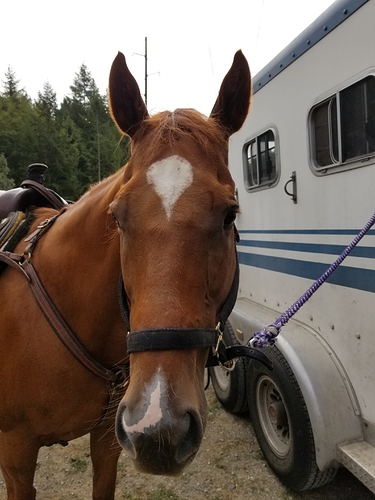I am hung up on the description of him “stabbing the ground”.
I am handicapped with MS and often get put up on horses who have problems, usually physical. They also have gaping holes in their training–at over 20 years old.
One mare I ride, an Arab-Welsh pony in her late 20s, has arthritis somewhere in her front legs. Her difficulties mostly show when we go down-slope, where she “stabs” the ground. I can feel it, the lady who owns her can see it, and it comes from arthritis pain. Since I ride this mare 100% at the walk now, most of my ride is finding the flattest path in a non-graded grass ring. When we have to go down-slope I do the collecting leg aids, which helps a little bit for a few seconds. This mare is very reluctant to go down-slope but since this is not an ideal riding ring I try to make it as painless as possible.
She is on various feed/supplement stuff, wears BOT exercise boots in front, has a BOT shimmable saddle pad, and a BOT exercise sheet. These help but the pain is always beneath the surface waiting for one wrong move to manifest. I would never jump this mare now even though she used to be a leased out eventing horse and knows how to jump.
“Stabbing” the ground is a sign of pain, or of a body that cannot work properly for whatever reason.
I ride another horse who is navicular. He is properly shod and quite good at walk, trot, canter (moves forward willingly and does not limp or bob his head) but my riding teacher refuses to let anyone jump him, which sort of limits his utility at a hunter barn. My riding teacher occasionally sends him over a cross-rails jump (6 inches high?), and usually what she sees is enough to make her wait for several months before they try this again, because this horse “TELLS HER” that it hurts too much. This horse is so amiable that he will try to do stuff and has never done anything dangerous for his rider, but that is what led him to end up with full blown navicular disease and a horrible shoeing bill.
Even when I used to jump horses I would have given the horse you ride a hard pass. There are many horses out there that are in better shape, have better legs, and are not dedicated to telling their riders that they hurt too much to land from a jump (over a thousand pounds landing on ONE LEG for a split second, it can hurt.)
It is simply not worth it if you end up crippled for life, unable to ride, walk, drive or work.

